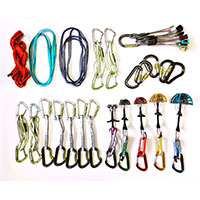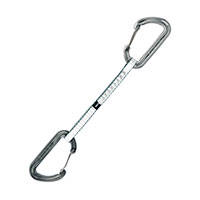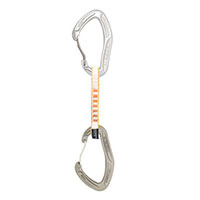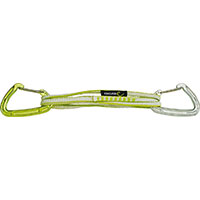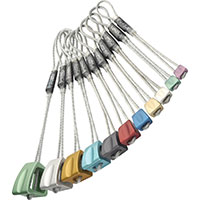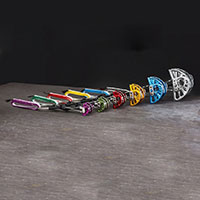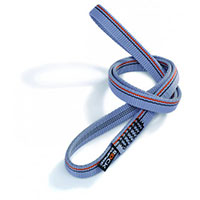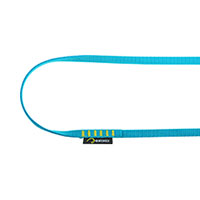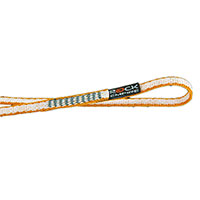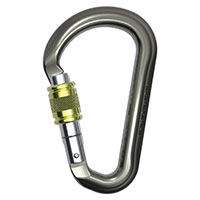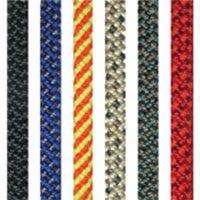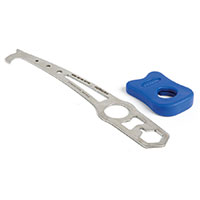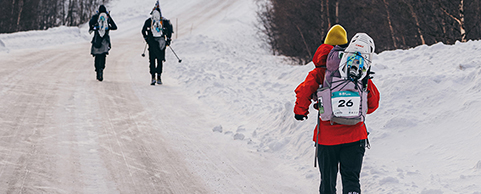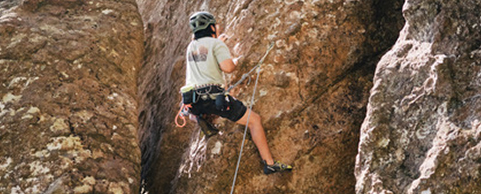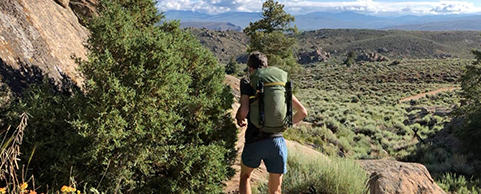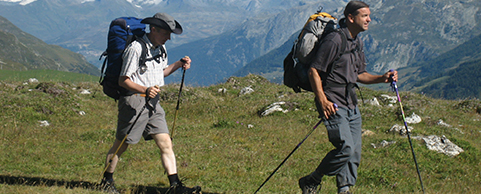How to Build a Trad Rack for Climbing

Basic elements: protection, carabiners and slings – how to make decisions on what type and how many of what you need.
A trad rack can throw open your choices for routes. But, where do you begin?
There are basic elements you need in order to climb a route on traditional gear:
- Quickdraws to attach your rope to the wall.
- Passive protection like nuts, RPs and hexes are placed in cracks in the rock.
- Active protection like cams are placed in cracks or pockets in the rock.
- Slings extend your quickdraws, or can be slung over 'chicken heads' or flakes.
- Locking carabiners are used to set up your anchor, or connect you to your anchor safely.
- A cordalette simplifies anchor set-up and makes things easier if you're not swinging leads.
How do you know what you need?
Really, it depends. Consider...
For instance, if you tend to climb short (10-20m), single-pitch routes, you could get away with less gear. But, this might not work if you like to place lots of gear.
Similarly, if you're climbing at a crag full of splitter cracks, such as Indian Creek (overseas), Ben Lomond (Tasmania) or Frog Buttress (Queensland), where the only pro is in parallel cracks, you'll probably need more cams than a person who climbs at a crag that's naturally well-protected like Arapiles, where it's possible to lead routes on only nuts.
Likewise, a cliff like Camels Hump in Victoria takes lots of hexes, but hexes are something you might not need on a standard rack.
The best approach to building a rack
Think about your needs. Where do you climb? How long are the routes you climb? Do you lace up routes, or protect them sparingly? Do you favour cams or nuts?
There's no one perfect answer. Assess your needs and choose gear accordingly.
Elements of a trad rack
Quickdraws
Lightweight Quickdraw
We recommend: DMM Phantom 18cm Quickdraw
Superlight quickdraws like the DMM Phantom help keep the general weight of your rack down. Phantom carabiners are extremely light (28g), thanks to being hot-forged (a metal-shaping process that produces light, strong gear). This means they're also strong - they're rated to a decent 23kN. The Phantom also features what DMM calls "I-Beam" construction - which means that if you take a cross-section of the carabiner, it's shaped like a letter I. This is another weight-saving design element. Finally, wire gates tend to be lighter than traditional solid gates.
The two carabiners (both Phantoms) are connected with a sewn 18cm length of 11mm Dyneema. For a sling, it's very narrow and very light. The whole package is light and strong, which makes it ideal for trad and alpine climbing.
Also consider:
Easy-to-clip Quickdraw
We recommend: Alpha Trad Wiregate Quickdraw 12cm
The Alpha Trad 'biner is a dream to clip. DMM added a kink to the spine to widen the gate opening, which makes it easier to drop a rope in. Snagging is also less likely thanks to the nose design, which is clean. Notches in places where your hand is likely to grip the 'biner while clipping give you a better grip. All in all, this is a good size 'biner for most hands, too, and it's fairly light at 34g.
Like most DMM quickdraws, the lower 'biner is attached to the sling with a rubber lining. This helps the 'biner stay correctly oriented. (Carabiners are strongest when the rope is in line with the spine.) On this quickdraw, the two carabiners (both Alpha Trads) are connected with a sewn 12cm length of light, strong 11mm Dyneema.
Also consider:
Extendable Quickdraw
We recommend: Edelrid Mission Set 60cm
This is an extremely lightweight extendable 'draw. Why do you need a quickdraw that extends? Long slings can be handy on routes where your pro might zig-zag - having a longer sling allows your rope to run in a straighter line, reducing rope drag.
But, a 60cm quickdraw hanging off your harness is not ideal. And, if you were to have the elements (two 'biners and a sling) racked separately, that means you would have to build a quickdraw mid-climb. That's fine if you have the endurance to hang around, but if you're pumped, it might not be fun.
That's why a set like the Mission Set is handy. It has two Edelrid Mission carabiners connected with a sewn 60cm length of 8mm Dyneema - very narrow and light. The setup is that of an 'alpine quickdraw', which you can easily extend when needed.
You can also build your own alpine quickdraw, using slings and carabiners of your choice. We stock a variety of carabiners and slings that we sell separately.
How many quickdraws do I need?
It depends.
Think about it this way: for every piece of gear you place, you'll need a 'draw. (Unless your piece of pro has an in-built sling and carabiner.)
With that in mind, the number of 'draws you need depends on how much gear you're likely to place. It also depends on the length of routes you usually climb.
If, for example, you place a fairly standard one piece of gear every 2-3 metres, and you usually climb routes up to 30 metres, you might need somewhere between 10-15 'draws.
Bear in mind, though, that you might need extra 'draws if you choose to back up any bad placements. Or, you might want extra 'draws to create a toprope setup on a sport route, for example.
Passive Protection
Nuts/Wires
We recommend: DMM Wallnuts Set 1-11
A full set of Wallnuts gives you 11 pieces sized 1-11.
Each size is colour coded, which makes it easier for you to find the piece you're looking for when they're all hanging off your harness. Ease of locating the right piece is also why DMM places the size label upside down.
Hexes
We recommend: DMM Torque Nut Set 1-4
Hexes are basically large nuts. Often, they're associated with ye olden days of climbing. But, they do have a place in modern climbing. They're an affordable solution for acquiring big gear. A DMM Torque Nut Set costs roughly the same as buying one cam (depending on size and brand, of course). Plus, you can use a hex as active pro by orienting the webbing in a direction that will make the hex cam when pulled.
Also consider:
How many?
Again, it depends.
A full set of wires could get you through most short climbs, in theory. But, you may need more wires if, for instance, you're climbing a crack that takes nuts of the same size the whole way up.
On longer trad routes - at Arapiles, for instance - it can also be handy to have a double set. Or, at least, doubles of the medium and small sizes.
Also consider:
Active Protection
Cams
We recommend: Wild Country New Friends
Cams are among the most expensive items you'll buy for your trad rack. It makes sense, then, to think hard about which ones you choose.
New Friends are a good balance between weight and durability. They're hot-forged, which makes them strong and light. The double-axle design gives it a greater range of movement, which means it will fit a greater range of cracks. The cam lobes (the part in contact with the rock) are non-anondised, brushed and notched, to give the cam better hold on rock. The extendable 12mm Dyneema sling saves you carrying a quickdraw. The whole unit has a smooth trigger action, which makes these cams nice to place.
New Friends come in sizes 0.5, 0.75, 1, 2, 3 and 4. Most climbers wouldn't carry a relatively big #4 Friend up every climb. But, the other sizes - particularly 1, 2 and 3 - are useful for medium-sized cracks. If your local crag has lots of small cracks, favour the smaller sizes, if your budget is limited.
You can fill in gaps in your size range with cams of other brands. Certain cams, like Aliens and Omega Pacific Link Cams have special features that make them the best option for particular placements. (Aliens are very flexible, and therefore better in horizontal placements. They're also great for pockets. Link cams work well in offset cam placements. They require care place well, though.)
Also, bear in mind, on certain crags and certain climbs, you may need double-ups.
Also consider: DMM Dragon Cams
Slings
Slings are handy in many situations: When you're building anchors, you can sling horns, for example. They're also handy for extending quickdraws on zig-zaggy routes. And, if you need to extend an anchor, or clip yourself into an anchor, you can use a sling (and carabiner).
Slings are also a cheap option if you need to bail off a route and leave a piece of gear behind. For example, compare the prices of a 60cm Rock Empire Nylon sling and a size 10 DMM Wallnut.
Because of their multitude of uses, it's handy having a selection of slings of various lengths and widths.
Here are some suggestions...
Multi-Purpose Do-It-All (Mostly) Sling
We recommend: Rock Empire Open Sling 16mm x 60cm
This is a good multi-purpose sling to have a few of. Nylon is a strong material, and more durable than Dyneema, which is a sling material popular with climbers because it's light.
Because of Nylon's durability, it's the best choice for uses like personal safety - e.g. clipping into an anchor. (For the latter, also consider the Sterling Chain Reactor - a safer version of the daisy chain.)
Really Big Slings
We recommend: Edelrid Tech Web Sling 12mm x 120cm
A couple of big slings can come in handy on particular routes.
Perhaps you're slinging a big flake, or a small turret at the top of a route. Maybe the most bombproof pro for an anchor is slinging a few solid features. A 120cm sling should give you the length you need to do this.
The Edelrid Tech Web Sling 12mm x 120cm has a Dyneema core, with an outside sheath made of Polyamide. This makes it more durable than Dyneema alone. (It also comes in 30, 60 and 90cm lengths.)
Also consider: Rock Empire Open Sling 16mm x 120cm
Dyneema Slings
We recommend: Rock Empire Dyneema Sling 10mm x 60cm
Dyneema is a great lightweight and narrow option. Thus, they're useful for creating alpine quickdraws, too.
Also consider: Edelrid Dyneema Sling 8mm x 120cm
Locking Carabiners
Broadly speaking, there are two categories:
These days, there are many types of locking carabiners.
Some have specific uses. The DMM Belay Master, for instance, is designed for use with your belay device. The DMM Rhino is designed for use with your GriGri.
If you're just starting to build a rack, get a few solid, multi-purpose locking carabiners like the DMM Aero HMS or DMM Boa. These are both beefy, classic carabiners.
We recommend screwgates if you're just starting out, because they're easy to unscrew using one hand. (And, there might be a situation that calls for that.)
Other Stuff
Cordalette
We recommend: Sterling 7mm Static Cord
A cordalette is a length of climbing cord, tied into a loop. Usually, this is done using two double-overhand knots.
It's up to you how long it is, but as an example, 8 metres of cord is a very usuable length for setting up a basic three-point trad anchor.
Some people don't carry cordalettes, because you can use your rope to set up an anchor. Where a cordelette comes in handy is if you're worried about running out of rope on a particularly long pitch.
It's also handy if you're not swinging leads on a multipitch.
Nut Tool
We recommend: DMM Nutbuster
Another optional extra.
But, the Nutbuster does make extracting nuts a little easier. It has a rubber handle, which means you can bash the end of your tool without worrying about the blade denting your hand.
Also consider: Wild Country Pro Key with Leash
We hope this article gives you a starting point for building your trad rack.
Questions? Visit us or call us on 03 9600 0599.
More Articles







